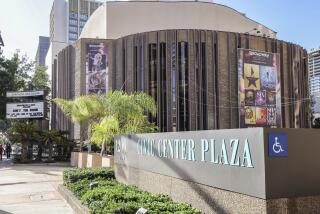Once Again, No One Bids on Torrance School Site
- Share via
Three months ago, Torrance school board members had awaited the opening of bids from prospective renters of the former Columbia School. Not a single bid was submitted.
On Tuesday night, they waited again.
For a second time, no bids were forthcoming.
Board members are clearly frustrated at the failure of their repeated attempts to keep from selling the vacant school by finding a long-term tenant.
“I don’t want to sell schools, but I don’t want to let them sit and rot, either,” said board member John Eubanks, who has been a chief proponent of leasing Columbia instead of selling it. Eubanks described himself as deeply disappointed that the second solicitation had faltered.
Torrance Unified School District officials said they will now look into alternatives to leasing, including selling the 4.95-acre school property at 4502 186th St. in northwest Torrance.
A total of 17 people or groups had picked up packets of information about the site, said district Supt. Edward Richardson. The board was asking a minimum first-year rent of $250,000 and a leasing period of up to 99 years. A renter could use the buildings or demolish them to make way for a new development.
District officials have estimated the renovation cost at $650,000, saying the tenant would be responsible for paying it. Windows at the one-story school are boarded up, and graffiti is scribbled on its walls. One potential tenant who became discouraged after months spent studying the school site is the Switzer Center, a Torrance-based school for learning-disabled and emotionally disturbed children.
The center chose not to submit a bid, said Janet Switzer, the center’s founder and executive director because “it’s still a very, very fierce price, I think.
“I certainly love the property. But my board is concerned about the tremendous amount of renovation it’s going to take. It’s just in such terrible shape.”
The former Columbia School has been vacant since the summer of 1988 as the district has puzzled over how to fill it. It is one of 15 schools the district has closed since 1969 in the face of plummeting student enrollment.
Ten of those schools were sold outright, and none was leased. Other South Bay school districts have leased a greater proportion of their vacant schools. That pattern angered some Torrance residents who say the district would earn more revenue by leasing its surplus schools instead of selling them.
State guidelines earmark the proceeds of a school sale for capital improvements, although rent can be applied to a variety of school uses.
District officials tried leasing the Columbia campus last spring for $380,000, but no bids were received by the June 4 deadline. The district then prepared to sell the property to the highest bidder at a minimum price of $3.5 million.
Instead, Eubanks and board member Ann P. Gallagher lobbied successfully for one last effort to find a renter. The school board agreed and voted July 2 to lower the rent to $250,000 and to open bids this week.
Torrance has not hired a consultant to market the property. The district has sought the aid of real estate experts in the past without much success, Richardson said.
Three independent consultants familiar with leasing vacant schools said Wednesday that, at first glance, the $250,000 rent is not unreasonable.
But the fact that no one submitted bids for Columbia School could reflect one of several problems, including possible flaws in how the district sought developers, said one consultant, Rush N. Hill of Newport Resource Management in Newport Beach.
He also said that the traditional bidding process can be too inflexible to produce the best deal.
“If I were retained as a consultant, one of my first questions to the board would be, ‘What are your needs? What are you trying to achieve? Would you be willing to take $100,000 for the first two years and then go to $400,000?’ ” He said he would also ask if the district wanted a percentage of the cash flow from the development on the site--a method used by the Redondo Beach City School District in leasing its vacant schools.
The current slowdown in the real estate market, Hill added, means that school districts must be even more creative to attract and keep developers.
Richard Godino, a Westwood lawyer who specializes in school property issues, has worked with the Redondo Beach district and has toured the Columbia School site. He is surprised no tenants have surfaced.
Godino agreed that traditional bidding is sometimes not the best avenue for finding developers.
“We’ve found a lot of problems with saying, ‘Hey, there’s a site. Does anyone want to bid on it?’ ” Godino said. “You’re just kind of casting around when you go out to bid.”
An alternative would have a district contact many developers, request their qualifications and then work with those more qualified in finally selecting a developer, said Godino.
“You’re really looking for a first-class developer . . . someone who can work with the neighbors and the City Council, and who has the ability to find financing in this difficult market,” he said.
Another consultant, Wayne D. Wedin of Orange County, questioned the Torrance leasing terms in which bidders were asked to submit 25% of the first-year rent with their bids.
“It is not unusual for a developer to be able to submit a proposal without any money or just a small amount,” Wedin said. “A lot of developers don’t like to put up money until they know they have a deal.”
More to Read
Sign up for Essential California
The most important California stories and recommendations in your inbox every morning.
You may occasionally receive promotional content from the Los Angeles Times.










